Age of Mythology Showcase: Odin
Our continuing showcases of the playable factions in Age of Mythology continue with the retainers of the mighty Norse god Odin.
The sixth edition in our continuing series of Age of Mythology showcases kicks off with a look at another god from the frozen north. We've already detailed two Greek and Egyptian gods, and now we unveil a second Norse deity: Odin, the ruler of the gods.
Interestingly, Odin wasn't always seen as a benevolent and compassionate god. He was aloof from man, a sometimes frightening and unapproachable deity. And despite his obvious leadership of the Norse pantheon, he was not as revered by the common man as other gods were. Indeed, most Vikings appreciated Thor's brawny demeanor and warrior status more than Odin's creepy, all-knowing wisdom.

Greg Street, one of the lead designers on Age of Mythology, explains the origins of Odin's great powers: "Odin embodied the gloomy and brooding nature of much of Norse mythology. He drove warriors into a berserker rage when in battle, put seers into a trance, and sent poets into a frenzy of creativity. He made great sacrifices for his wisdom, including giving up an eye to drink from the well of Mimir, and hanging himself with his own spear from the World Ash, Yggdrasil, for nine days to learn the power of songs and runes. Odin was credited with creating the first humans (by breathing life into driftwood) and gave his name to Wednesday (Wotan's day), much as Thursday comes from Thor and Friday comes from Frigg. Odin was a sage and magician who ruled the other gods. His two ravens, Hugin and Munin, flew out into the world every day to report to Odin what they saw and heard. His spear, Gungnir, never missed its mark, and his ring, Draupnir, cloned itself to create other golden rings every ninth night. His horse, Sleipnir, ran on eight legs, and his wolves, Freke and Gere, were fed all of Odin's meat, for the jarl of the gods survived only on mead."
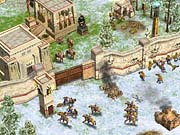
Worshippers of Odin gain a variety of benefits to reflect their patron's own diverse interests. Amongst Odin's bonuses are better scouting capabilities, a good hunting bonus, and stronger elite units. In mythology, Odin relied on his two ravens to bring him knowledge of the world, and in the game, the Odin player gets access to those same two ravens as ready scouts. As soon as an Odin player builds a temple, the ravens automatically appear. They are purely recon units, with no attack abilities, but thanks to their flight, they provide scouting capabilities unmatched by the Thor or Loki player. Better yet, you don't need to buy the ravens, and if they are killed, they respawn in similar fashion to the Egyptian pharaoh.
Hunting in Age of Mythology is more important than in previous Age games. You can still farm and fish (although Greek and Norse players can't farm until the second age), but both endeavors are expensive and risky, because fishing ships and farms are more vulnerable than ever before to hit-and-run attacks. Now, herding animals is more extensive in Age of Mythology, but herd animals fatten up over time, producing more meat the longer you let them live. Thus, you'll often end up saving your herd animals for a bigger payoff later in the game. Thus, hunting becomes a much more viable source of food in the early game. And Odin has both a small hunting bonus and a hunting-oriented god power. This really helps him jumpstart his economy much faster than other gods.
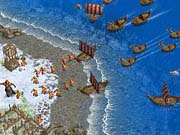
Finally, Street explains the elite unit bonus: "Whereas Thor tends to train lots of cheaper Norse units, Odin focuses on the more powerful, elite units at the hill fort. All of Odin's hill fort units have a hit point bonus, and all of Odin's human soldiers (meaning military units except for myth units, siege, and ships) regenerate hit points. Much like the priest's healing (and all healing in Age of Mythology), the regeneration is faster when a unit is not in combat, which encourages its use in between battles and not to just keep a unit from dying in combat."
Odin's Army
To understand the military capabilities of Odin's followers, it's necessary to take a closer look at the Norse military units.
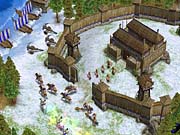
Like the Egyptians, the Norse divide their troops between two buildings: a barracks-type building for low level units and a fortress for elite units. Says Street, "The Norse longhouse provides the backbone of [that faction's] army. However, like the Egyptian military, the Norse have elite soldiers in the hill fort. The difference between the Norse and the Egyptians is that the Norse tend to always train their basic soldiers and support them with the elite ones, whereas Egyptians often shift entirely to the Migdol [fortress] soldiers when they become available."
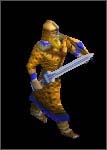
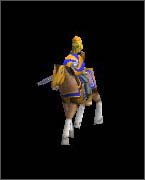
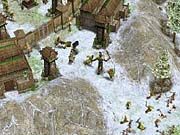
As for cavalry, in Ensemble's estimation, the jarl is the best one in the game. According to Street, "This powerful and expensive unit is based on the Norse nobility and rulers (the words "jarl" and "earl" probably came from the same root). Age of Mythology's jarl has the hit points of a myth unit, with the cost to match. They are relatively slow for cavalry, but they have a small bonus against myth units, making them a nice hersir substitute (though they do not generate extra favor the way that a hersir does). Because Odin was the god of the nobles, Odin's hill fort bonus piles on even more hit points to the jarl, making them popular with Odin players."
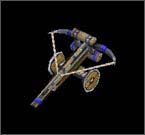
Gods and Monsters
Now we come down to the essence of Age of Mythology: fantastic gods and mythological units. In truth, all the mortal units pale in comparison with the majesty of giants, hydras, colossi, and other great beasts. And the spectacular god powers are well worth the time and money invested in raising troops and massacring enemies for the favor of Norse gods. All the grabbing of territory and gathering of food, gold, and wood is just a means to an end: the summoning of divine power in the form of myth units, myth improvements, and god powers.
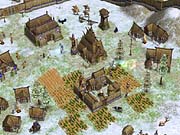
When you first start as an Odin player, you have access to the deity's god power and myth improvement. Odin's god power is called the great hunt. When cast, it doubles the number of animals in the casting area. If there were eight boars before the spell, there are 16 when the power is complete. Says Street, "Odin players often scout around to find a large herd of deer or zebras and may even move their goats or cows into this area before using the god power. Really crafty players like to combine the great hunt with a Poseidon ally's lure god power (also known as the "animal magnet") to really get a lot of animals in one place [to get even more out of the power]. Odin's mythological improvement, lone wanderer, does not aid in hunting but instead bolsters the speed of his ulfsarks. This makes them better scouts for early exploration and gives them a greater chance of countering cavalry and fleeing or rushing archers.
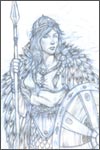
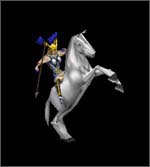
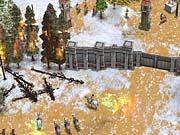
In contrast with Odin's god power, Freyja's is much more destructive. It is called forest fire, and it can destroy whole forests. "It can be used to deny early wood resources to an enemy by removing an entire nearby forest," says Street, "and it can also destroy weaker buildings near the forest. It is particularly sneaky to forest-fire a forest that enemies have used as a partial wall around their town."
Of course, we've covered the gods of only the first two ages. It gets better.
Heroic Gods
In the heroic age, the Odin player can choose to worship Njord or Skadi. Skadi, who we detailed in the Thor showcase, is a good complement to Odin. She was a frost giant who married into the Norse pantheon. Seeking revenge on the Norse gods for the death of her father at Thor's hands, she could not be placated until she was offered a Norse god as a husband. She had to choose amongst the eligible bachelors of the pantheon, but she could do so only by looking at their feet. She coveted the god of beauty, Baldr, but when she chose the most beautiful feet from the bunch, those turned out to belong to Njord, who, as god of the sea, had his feet washed clean every day. Njord, is, of course, Odin's other choice in the heroic age, and he provides some valuable water map bonuses.
Let's first give a little more background on the dynamics of sea battles in Age of Mythology. There are three basic warships in the game--archer ships, siege ships, and ramming ships--and they follow the rock-paper-scissors balancing model. "Archer ships," explains Street, "like the Norse longboat and Greek trireme, have range and are good at taking out enemy fishing ships. These ships are beaten by the heavy, slow-moving siege ships that attack like catapults. The siege ships are in turn beaten by the nimble ramming ships. The ramming ships use a hammerlike weapon that the Greeks called a dolphin, which was used to pound through enemy hulls. Because 'dolphin ship' doesn't sound very menacing, we call them ramming ships or hammer ships. The hammer ships can close with the siege ships quickly to cave in their hulls, but their pierce armor is poor, which makes them vulnerable to archer ships."
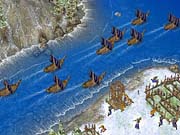
Street explains the reasoning behind giving the Norse some slight advantages on the high seas: "While we didn't want to give the Norse so many intrinsic naval bonuses that the Greeks and Egyptians would be avoided on water maps (and to be fair, the Egyptians and Greeks were famous seafarers in their own rights), we knew players would expect to be able to focus on a naval strategy as Norse, and choosing Njord as a heroic age god certainly helps. Njord was one of the Norse gods of the ocean--particularly sailing."
Choosing Njord immediately gives you access to his two mythological units: the mighty mountain giant and the ship-tossing kraken. The mountain giant is a burly and huge melee warrior who can flatten mortal units with a few swipes of his club. Street even goes as far as to say that "the mountain giant is rightfully the most powerful myth unit in Age of Mythology, at least in terms of hit points (1,200 at last count). He is slow to wade into combat but hard to put down. His special ability is a windup smash with his club against buildings. He also alternates between his club and kicking smaller units [sending them flying]." As a god of the ocean, it is only natural that Njord can call on a sea monster as his second myth unit to aid Odin. Street points out, "The kraken (despite the Clash of the Titans movie, the monster is Norse in origin) is a giant cephalopod that can grab ships and hurl them to their doom."
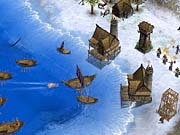
Njord has three mythological improvements. His "wrath of the deep" upgrade makes krakens even more powerful, while ring-giver upgrades the land-roaming jarl cavalry unit. His final myth technology is long serpent, which improves all Norse warships.
So with his great mythological units, myth techs, and significant water bonuses, does Njord get chosen in every naval game? "Not necessarily," says Street. "Consider a god like Loki, who can choose between Njord and Bragi. Njord delivers the kraken and some naval improvements, but Bragi helps out myth units, which Loki excels at. To choose one minor god, you give up the strengths of another minor god (and it is having to make these decisions which makes Age of Mythology so much fun)."
The Final Age
In the mythic age, the final god choice is made. Odin, like Thor, can choose between Tyr or Baldr. Tyr was profiled in the Thor showcase, although at that time, he still had the ragnarok god power. Since then, things have changed.
Baldr was the Norse god of beauty, although Street says that this specialization is actually "a little less sissified in the grim Norse mythology than it might otherwise sound." According to Street, "Most of the stories about Baldr concern his death. Because of a prophecy concerning Baldr's death, his mother, Frigg (wife of Odin), exacted a promise from every living creature not to harm Baldr. Thinking him invincible, the other gods then celebrated by using Baldr for target practice. However, Frigg had failed to get a promise from the mistletoe plant, so the wicked Loki tricked Baldr's own blind twin brother, Hod, into throwing a dart of mistletoe at Baldr. The god of beauty was slain and went to dwell in the Norse underworld. Determined to free him, Frigg went to Hel, the goddess who ruled the underworld, and asked for Baldr' return. Hel agreed that Baldr could be restored if every living creature wept for him. Loki alone refused to weep, and so Baldr stayed in the underworld." But some tales say that Baldr will return to lead the surviving gods after Ragnarok. That's probably why he ended up getting the god power of the same name instead of Tyr.
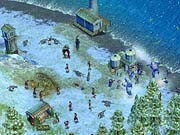
Street relates, "Although we reported that Tyr got the ragnarok god power, we have since switched them so that Baldr gets ragnarok and Tyr gets a god power known as fimbulwinter. Fimbulwinter is a particularly wicked god power based on one of the omens for the end of the world--three winters in a row without summer. When you call for a fimbulwinter in Age of Mythology, the sky turns dark and snow falls, even on the Egyptian desert. Then the wolves come. There are many wolves, and they unerringly strike at enemy town centers and the villagers around them. If there are no villagers left to kill, the wolves will turn on soldiers and buildings. Although you cannot control the wolves, you do gain their line of sight and use them to see enemy towns across the map. When the fimbulwinter ends, the wolves go away, the sun comes out, and the survivors must try to restart their economies."
Baldr comes with only one myth unit, the fire giant. This behemoth is wreathed in flames, and he hurls fireballs at nearby enemies. According to Street, "His special attack involves a windup and pitch of three fireballs that bounce along the ground, damaging everything, especially buildings, in their path. Mountain giants are scary (especially given that they come in the third age), but the ranged attack of a fire giant makes it even scarier, especially in groups."
Like Njord, Baldr has three mythological improvements. Arctic Gale improves the armor and speed of Norse siege ships (called dragon boats), dwarven auger enhances the portable ram, and sons of sleipner give the otherwise weak raiding cavalry a significant attack bonus against archers and throwing axemen.
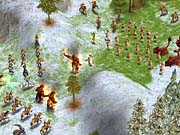
That's it for the all-knowing Odin and his entourage of Asgardian gods. So now that we've finished our look at the second Norse divinity, we'll return to the Greek isles with our next showcase to profile the third and final Greek god. He has powerful archers, strong buildings, and the formidable power to raise an army of the dead.
Got a news tip or want to contact us directly? Email news@gamespot.com
Join the conversation